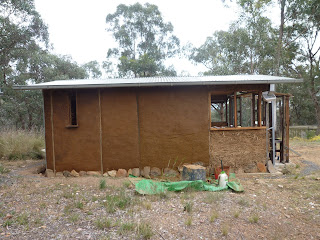 |
| Fresh render, East Wall |
Well, I couldn't put it off forever, so yesterday I finally got it together to apply a fine new garment of render to the west wall.
This marks an important turning point in the mud shed building, because the framing (TJ's job) is nearly complete and the mud work (my job) becomes the main task. In case you haven't noticed, I've been procrastinating like crazy. It's hard work, but now I've started, I feel better about it and I'm looking forward to doing more rendering next weekend.
The big difference is, I finally got the phone number of that guy who runs a dairy down the road, rang him up and arranged to come and collect some fresh cow poo from the milking shed for the render mix.
Cow poo is the magic ingredient in a good mud render. It binds the other ingredients, adds fibre (finely chopped grass), makes the mix easier to handle and when the mix dries, it is harder and more weather resistant. And here's a great steaming bucket of it for your enjoyment.
 |
| Not as stinky as you might think |
This is the first coat ("parging coat") of render. Its task is to stick to the walls, fill all the bumps and make a smooth, flat surface. So it contains a lot of chopped straw (I just use chaff, because it's cheap and pre-chopped).
The mud I used this weekend didn't have enough clay in it, so it didn't want to stick to the wall. It was really hard going. It didn't want to stick, and I had to keep scraping it up and re-applying it, pushing it into the surface. I wanted to throw the whole mix out, but where would I throw it? The easiest way to dispose of it was on the walls.
So once I finished the patch I set out to do, to the left of the door, I just kept rendering.
 |
| Before (the green stuff is masking tape) |
 |
| After! |
Funnily enough, after spending a day covering the walls, I didn't feel like I had added something to the shed so much as uncovered something. With the excess straw trimmed and clothed, you can see the structure better. The rocks, the frame, the curved door surrounds.
 |
| With and without render |
I also got around to finishing that patch of the south wall that was left bare all winter after I ran out of render
that day back in April.
 |
| South wall patch |
I'll be interested to see how different the two mixes are once they are dry. The mix from April was full of clay (it's the colour of terra cotta!), so it stuck to the wall like anything but it has cracked a lot. Cracks in the first coat are OK, so long as the render doesn't peel off.
Today's mix was brown and full of silt, which feels superficially like clay (that's how I made the mistake), so it was difficult to apply. But once it was on the wall it was easy to manipulate. I was able to shape it and make it flat. I'll be interested to see what it's like when it dries.
 |
| 1st coat ("parging coat") render - fluffed up with straw |

















































